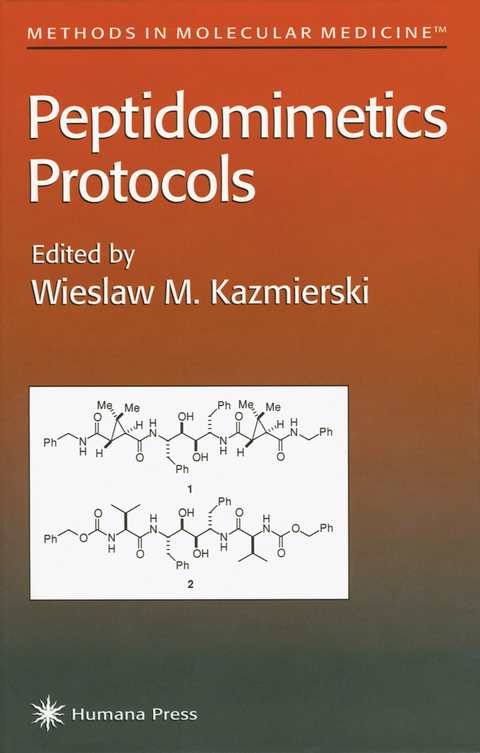
Peptidomimetics Protocols
Humana Press Inc. (Verlag)
978-0-89603-517-1 (ISBN)
Synthesis and Use of Pseudopeptides Derived from 1,2,4-Oxadiazole-, 1,3,4-Oxadiazole-, and 1,2,4-Triazole-based Dipeptidomimetics.- Synthesis of Aminobenzoic Acid-Based Nonpeptide Templates: Applications in Peptidomimetic Drug Discovery.- Synthesis of an Esterase-Sensitive Cyclic Prodrug of a Model Hexapeptide Having Enhanced Membrane Permeability and Enzymatic Stability Using an Acyloxyalkoxy Promoiety.- Synthesis of an Esterase-Sensitive Cyclic Prodrug of a Model Hexapeptide Having Enhanced Membrane Permeability and Enzymatic Stability Using a 3-(2?-Hydroxy-4?,6?-Dimethylphenyl)-3,3-Dimethyl Propionic Acid Promoiety.- Synthesis of Coumarin-Based, Esterase-Sensitive Cyclic Prodrugs of Opioid Peptides with Enhanced Membrane Permeability and Enzymatic Stability.- Azatides as Peptidomimetics: Solution and Liquid Phase Syntheses.- Synthesis of Cbz-Protected Ketomethylene Dipeptide Isosteres.- (E)-Alkene Peptide Bond Isosteres by Cuprate Opening of Vinyl Aziridines.- Syntheses of Norstatine, Its Analogs, and Dipeptide Isosteres by Means of ?-Lactam Synthon Method.- Synthesis of a Versatile Peptidomimetic Scaffold.- An Asymmetric Synthesis Protocol to Prepare Topographically Constrained ?-Substituted Aromatic Amino Acids.- Synthesis of Oligopeptides Containing an Oxirane Ring in the Place of a Peptidic Bond.- Synthesis of Protected Lactam-Bridged Dipeptides.- Synthesis of Peptidomimics Through Sugar-Based Scaffolds.- The Synthesis of Bicyclic Piperazinone and Related Derivatives.- Synthesis of Dipeptides with ?[CH20] Amide Bond Mimetics.- SNAr-Based Cycloetherification Methodology: Application in the Synthesis of Heterodectic Macrocyclic Peptides with Endo Aryl-Aryl and Aryl-Alkyl Ether Bonds.- Cyclic Aromatic Amino Acids with Constrained ?1 and ?2 DihedralAngles.- Asymmetric Syntheses of Unnatural Amino Acids and Hydroxyethylene Peptide Isosteres.- Fluoroolefin Isosteres.- Synthesis of 3-Amino-l-CarboxymethyI-Benzodiazepine (BZA) Peptidomimetics.- A Conformationally Restricted ?-Strand HIV Protease Inhibitor.- Synthesis of Cyclopropane-Containing Leu-Enkephalin Analogs.- The 1,5-Disubstituted Tetrazole Ring as a cis-Amide Bond Surrogate.- Synthesis of (2R, 3R, 4R, 5S)-5-tert-Butyloxycarbonylamino-3,4-Dihydroxy-2-1sopropyl-3,4-O,O-Isopropylidene-6-CyctohexyI-Hexanoic Acid.- Synthesis of (2S, 4S, 5S)-5-(t-Butoxycarbonylamino)-4-(t-Butyldimethylsilyloxy)-2-Isopropyl-7-Methyl Octanoic Acid.- Synthesis of ?-Vinyl Amino Acids.- A Novel Synthetic Protocol for the Preparation of Enantiopure 3-, 4-, and 5-Substituted Prolines.- Synthesis of Aminobenzoic Acid-Based Nonpeptide Templates.- Aminimides as Peptidomimetics.
| Erscheint lt. Verlag | 19.10.1998 |
|---|---|
| Reihe/Serie | Methods in Molecular Medicine ; 23 |
| Zusatzinfo | XXX, 549 p. |
| Verlagsort | Totowa, NJ |
| Sprache | englisch |
| Maße | 155 x 235 mm |
| Themenwelt | Medizin / Pharmazie ► Medizinische Fachgebiete ► Pharmakologie / Pharmakotherapie |
| Medizin / Pharmazie ► Pharmazie | |
| Medizin / Pharmazie ► Studium | |
| Naturwissenschaften ► Biologie ► Biochemie | |
| Naturwissenschaften ► Chemie ► Physikalische Chemie | |
| ISBN-10 | 0-89603-517-4 / 0896035174 |
| ISBN-13 | 978-0-89603-517-1 / 9780896035171 |
| Zustand | Neuware |
| Haben Sie eine Frage zum Produkt? |
aus dem Bereich


